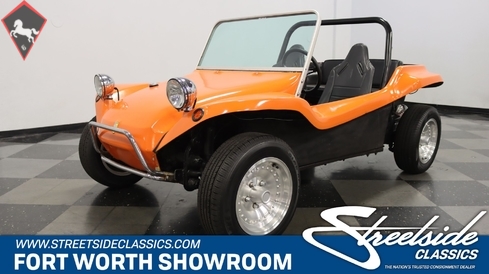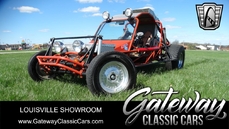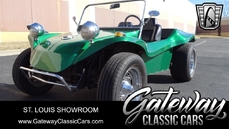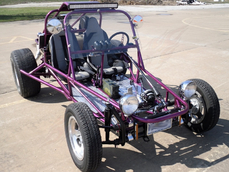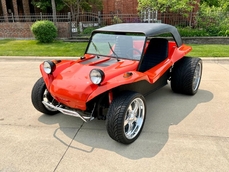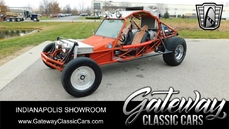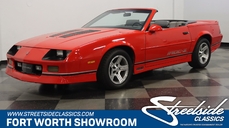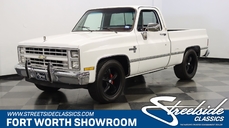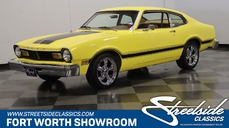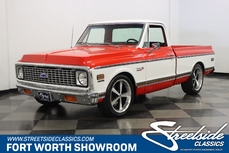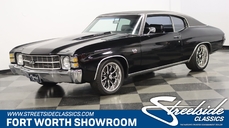Volkswagen Beach Buggy Buggy 1600 CC 1964
General description :
Description
This eye-catching 1964 Volkswagen Dune Buggy is a perfect example of when the automobile is distilled into 100% pure fun. Sure, it's actual transportation that can go from A to B, but the reason this car was built was to put a big grin on your face - and not much else. With a great-running 1600cc Flat 4, a quick-shifting 4-speed manual, and loads of style in its bright orange package, this little troublemaker is ready to tear up the beach and provide the next owner with loads of fond memories.
We can all but guarantee you'll be the only person tooling around in one of these, even though the look is instantly familiar to anyone that's ever been on a beach vacation. Unlike, say, the T-Bucket, this is not just some 2-seater that can only go in a straight line. No, this open-air beauty hauls four people and can handle itself in sand, mud, asphalt, and maybe even a little water if you keep the exhaust clear (think deep puddles or the ocean's shore for some killer rooster tails, not the bottom of a lake). There's not much to the lightweight fiberglass body, but what you get is pretty darn awesome – sharp front fenders, a squared-off deck in back, and an exposed bottom bucket and suspension - and the whole design is very professional and was well-executed years back so nothing looks sub-standard. Repainted long ago and showing its fair share of imperfections throughout, it still presents really well in bright orange paint with a nice soft shine, and the fiberglass is in good condition with no cracks, splintering, or any structural issues to worry about. This is motoring down to its barest essence, so there isn't much chrome save for the bull nose push bumper and bug-eyed headlights up front, and that big, upright windshield. The protruding roll bar adds to the look and the overall safety of the Buggy, and out back the VW Beetle engine becomes an integral part of the overall look with the serpentine exhaust exiting upwards and stealing the show.
More minimalism inside where simple pleated black vinyl looks good, wears well, and is weather-resistant enough for its alfresco duties. The front buckets are sporty and provide more support than you usually find in a Buggy, while out back the rear bench will fit four of your more diminutive friends in a pinch. Hop over the side of the tub and it's easy to settle in behind the 3-spoke steering wheel, where you'll find that the driving position is more early British roadster than German economy car, and with those big pontoon fenders out there, you can clip apexes more easily than you ever thought possible. Creature comforts are few and that's entirely the point here; anything that wasn't necessary for the job of having fun was omitted. That means no windshield wipers, no heater, not even a radio, simply because you'll be blasting along having too much fun to need to worry about additional entertainment. The VW's original gauge pod was neatly installed in the dash and the blacked-out shifter jutting out from the floor falls easily into the driver's hand. Floor coverings are institutional and easy to maintain, which is this car's mantra, and the rear seat lifts up to reveal the battery.
VW's air-cooled flat four needs no introduction, and this 1600cc unit provides plenty of power for the flyweight dune buggy. Dressed neatly with lots of chrome and with signs of maintenance throughout, the engine is equipped with the usual hop-up parts, including a bigger carburetor, and an exotic headers and an EMPI exhaust that as much of a styling element as noise suppression system. The Beetle's 4-speed manual transmission and floor pan made the transition intact and with the low center of gravity, handling is adept, even in the loose stuff out on the beach. Obviously, this was never someone's winter beater, so the underside remains in very good order with no glaring trouble spots. Finned aluminum helps with the air-cooled engine at seed and you'll undoubtedly find that this car loves to play. Aftermarket smoothie race wheels bolt right on and carry the classic staggered look with 175/70/14 front and 205/60/15 rear tires that look positively gigantic on the tiny car's frame.
If you've ever driven one of these, then we just wasted our time attempting to espouse the car's virtues in print because it's impossible to capture in words how incredibly fun a Dube Buggy really is. This one has all the right ingredients, including a strong air-cooled motor and a vivid presentation. With warm weather right around the corner, this baby hit the market just in time. Call today!
Features : Vinyl Interior ,
1964 Volkswagen Beach Buggy Buggy 1600 CC is listed for sale on ClassicDigest in Dallas / Fort Worth, Texas by Streetside Classics - Dallas/Fort Worth for $14995.
Car Facts
Car type : Car Make : Volkswagen Model : Beach Buggy Model Version : Buggy 1600 CC Engine size : 0.0 Model Year : 1964 Sub type : Convertible Location : Dallas/Fort Worth Vehicle Registration : Undefined
14995 $
Seller Information
Streetside Classics - Dallas/Fort Worth
Streetside Classics - Dallas/Fort Worth
(817) 764-8000
Streetside Classics - Dallas/Fort Worth
(817) 764-8000
People who viewed this Volkswagen Beach Buggy also viewed similar Volkswagen listed at ClassicDigest
Other cars listed for sale by this dealer
About Volkswagen
The Volkswagen story is indeed an intriguing tale of innovation, resilience, and post-war revival, marked by various models that have become iconic in automotive history.The People's Car (Volkswagen): Initially envisioned by Adolf Hitler in the 1930s as a "people's car" or "Volkswagen" in German, the idea was to create an affordable and practical vehicle for the German people. This concept led to the development of the Volkswagen Beetle (or the Type 1), designed by Ferdinand Porsche.
Post-War Challenges: After World War II, Volkswagen faced significant challenges. The factory was heavily damaged, and the brand's association with the Nazi regime led to a lack of interest in the car in some regions.
British Intervention - The British Army & Ivan Hirst: The British Army took control of the factory in the immediate post-war period. Major Ivan Hirst, a British Army officer, played a crucial role in reviving Volkswagen. He recognized the potential of the Beetle and advocated for its production, convincing the British military to order several thousand cars. This decision helped jumpstart the brand's revival.
Export Success and the Beetle's Global Appeal: The Beetle gained popularity not only in Germany but also globally, becoming an icon of affordable motoring. Its simple, reliable design and unique appearance made it a favorite among consumers worldwide.
Model Evolution: Over the years, Volkswagen introduced various models alongside the Beetle, each contributing to the brand's growth:
Type 2 (VW Bus or Transporter): Introduced in the 1950s, it became an iconic symbol of the hippie movement in the 1960s, loved for its spaciousness and versatility.
Golf (Rabbit in the U.S.): Launched in the mid-1970s, the Golf (or Rabbit in the U.S.) marked a shift towards front-wheel-drive, modern design, and hatchback practicality, becoming a cornerstone of the brand's success.
Passat, Jetta, and Other Models: Volkswagen expanded its lineup with models like the Passat and Jetta, catering to different market segments.
Challenges and Innovations: Despite success, Volkswagen faced challenges, including quality issues in the 1970s. However, the brand continued to innovate and develop new models and technologies.
Rise of the GTI and Global Expansion: The 1980s saw the rise of the iconic Golf GTI, a high-performance version that sparked the hot hatch trend. Volkswagen also expanded its global presence during this period.
The British intervention in reviving Volkswagen after World War II played a pivotal role in the brand's resurgence. While there might have been some tensions or competition among automotive companies in the 1950s and 1960s due to Volkswagen's post-war success, the brand's ability to produce innovative and popular models solidified its place in automotive history.
